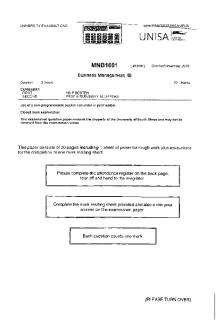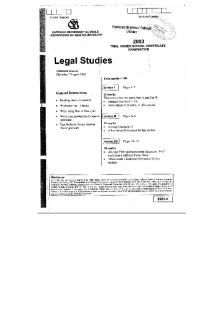ECO1005 exam 2018-9 - Past Paper PDF

| Title | ECO1005 exam 2018-9 - Past Paper |
|---|---|
| Course | MATHEMATICS FOR ECONOMICS |
| Institution | University of Surrey |
| Pages | 3 |
| File Size | 143 KB |
| File Type | |
| Total Downloads | 38 |
| Total Views | 128 |
Summary
Past Paper...
Description
ECO1005/3/SEMR2/18/19 (1 hand-out)
UNIVERSITY OF SURREY© Faculty of Arts & Social Sciences School of Economics Undergraduate Programmes in Economics
ECO1005: Mathematics for Economics FHEQ Level 4 Examination
Time allowed:
2 hours
Semester 2 2018/9 Answer all FOUR questions Each question carries equal marks
Where appropriate the mark carried by an individual part of a question is indicated in square brackets [ ].
Calculators are permitted providing they are non-programmable and not wireless enabled
Additional materials: 1 hand-out (Formula sheet)
©Please note that this exam paper is copyright of the University of Surrey and may not be reproduced, republished or redistributed without written permission 1
ECO1005/3/SEMR2/18/19 (1 hand-out)
Question 1 A consumer’s utility function is 𝑈 = 𝑥10.25 𝑥20.75, where 𝑥1 and 𝑥2 are the quantities consumed of goods one and two, respectively. The prices of goods one and two are £2 and £4, respectively, and the income available to spend is £100. (a) Using the Lagrangean method, determine the maximum utility.
[70%]
(b) Interpret the optimal value of the Lagrange multiplier.
[30%]
Question 2 Consider an investment that involves an initial cost of £150, and produces cash inflows of £𝑥 at the end of year 1 and of £𝑥 at the end of year 2. (a) Derive an expression for the Internal Rate of Return (IRR) as a function of 𝑥.
[50%]
(b) Suppose now that the yearly available interest rate is 2% compounded daily, and 𝑥 equals 200. What is the Net Present Value (NPV) of the investment? [50%]
Question 3 Consider the series 𝑆𝑛 associated to the sequence 𝑎𝑛 = 𝐴(1 + 𝑟)𝑛−1 , for 𝑛 = 1,2, …, where 𝐴 and 𝑟 are constants. (a) Derive 𝑆𝑛 .
[70%]
(b) Suppose now that 𝑛 is large. What is a good approximation to 𝑆𝑛 if −1 < 𝑟 < 0? What if 0 < 𝑟 < 1? [30%]
[SEE NEXT PAGE] 2
ECO1005/3/SEMR2/18/19 (1 hand-out)
Question 4
(a)
Evaluate the integral
3
(ln(𝑥 + 1)) 𝑑𝑥 ∫ 𝑥+1 1 2
[35%] (b)
Evaluate the integral ∫ 𝑥 √1 − 𝑥 𝑑𝑥 [35%]
(c)
Suppose the function 𝑓(𝑥, 𝑦) is homogeneous of degree 𝑘, and has continuous secondorder partial derivatives 𝑓𝑖𝑗 (𝑥, 𝑦), for 𝑖, 𝑗 = 1,2. Show that 𝑥 2 𝑓11(𝑥, 𝑦) + 2𝑥𝑦𝑓12(𝑥, 𝑦) + 𝑦 2 𝑓22(𝑥, 𝑦) = 𝑘(𝑘 − 1)𝑓(𝑥, 𝑦). (Hint: apply Euler’s theorem to the first-order partial derivatives of 𝑓(𝑥, 𝑦))
[30%]
Internal Examiner: Federico Martellosio [END OF PAPER]
3...
Similar Free PDFs

ECO1005 exam 2018-9 - Past Paper
- 3 Pages

STAT270 - past exam paper
- 24 Pages

Past exam Paper 2018
- 23 Pages

Trial past exam paper
- 7 Pages

MA103 Past Paper Exam
- 5 Pages

2010 exam - past paper
- 25 Pages

KIT710-2015 - past exam paper
- 6 Pages

Past Exam Paper 2017-2018
- 2 Pages

2016 s2 - past exam paper
- 16 Pages

ANS333 Past exam paper 2015
- 10 Pages

SBL Past Exam Paper 2019
- 20 Pages

Criminal Law Past Exam Paper
- 16 Pages

all india bar exam past paper
- 10 Pages

AQA 71321 QP JUN17 - Past Exam Paper
- 24 Pages

Uob past paper
- 4 Pages

Legal Studies Past paper
- 18 Pages
Popular Institutions
- Tinajero National High School - Annex
- Politeknik Caltex Riau
- Yokohama City University
- SGT University
- University of Al-Qadisiyah
- Divine Word College of Vigan
- Techniek College Rotterdam
- Universidade de Santiago
- Universiti Teknologi MARA Cawangan Johor Kampus Pasir Gudang
- Poltekkes Kemenkes Yogyakarta
- Baguio City National High School
- Colegio san marcos
- preparatoria uno
- Centro de Bachillerato Tecnológico Industrial y de Servicios No. 107
- Dalian Maritime University
- Quang Trung Secondary School
- Colegio Tecnológico en Informática
- Corporación Regional de Educación Superior
- Grupo CEDVA
- Dar Al Uloom University
- Centro de Estudios Preuniversitarios de la Universidad Nacional de Ingeniería
- 上智大学
- Aakash International School, Nuna Majara
- San Felipe Neri Catholic School
- Kang Chiao International School - New Taipei City
- Misamis Occidental National High School
- Institución Educativa Escuela Normal Juan Ladrilleros
- Kolehiyo ng Pantukan
- Batanes State College
- Instituto Continental
- Sekolah Menengah Kejuruan Kesehatan Kaltara (Tarakan)
- Colegio de La Inmaculada Concepcion - Cebu